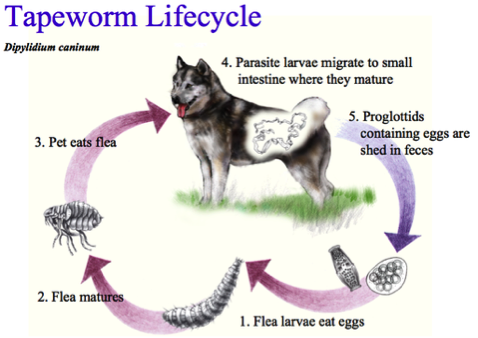Tapeworms are common parasites that live in the small intestine of dogs, cats and other animals. Tapeworms are made up of a large head and many small segments. The segments break apart in the feces and will stick to the anus and tail, looking like moving grains of rice. As the segments break apart the head remains attached the intestinal wall where it develops more segments.
There are multiple types of tapeworms depending on how the pet becomes infected. Dipylidium caninum, the most common tapeworm of dogs and cats, is transmitted by fleas. Dogs and cats become infected with this tapeworm by ingesting fleas (during self grooming and licking). Two other types of tapeworm are also very common. Taenia pisiformis in the dog, and Taenia taeniaeformis in the cat are transmitted by rabbits and rodents (mice, rats squirrels). Dogs and cats become infected after ingesting one of these infected animals.


Once infected with tapeworms the pet may have digestive upset, poor appetite, poor haircoat and skin, weight loss, and mild abdominal discomfort. Some pets will “scoot” their backside across the floor due to the sensation of the segments moving around on their anus and tail.
Tapeworms are diagnosed by identifying the segments in the pet’s bedding, feces, or clinging to the hair around the anus and tail. Tapeworm eggs are not always seen on during microscopic examination of the feces.
The medication for tapeworms kills the adults worms preventing further segment development. Dipylidium caninum tapeworm infections are prevented by continuing flea prevention all year. Taenia tapeworm infections are controlled by reducing the pet’s contact with other intermediate hosts like rabbits and rodents. Monthly use of some heartworm preventions helps treat and control tapeworm infections.

